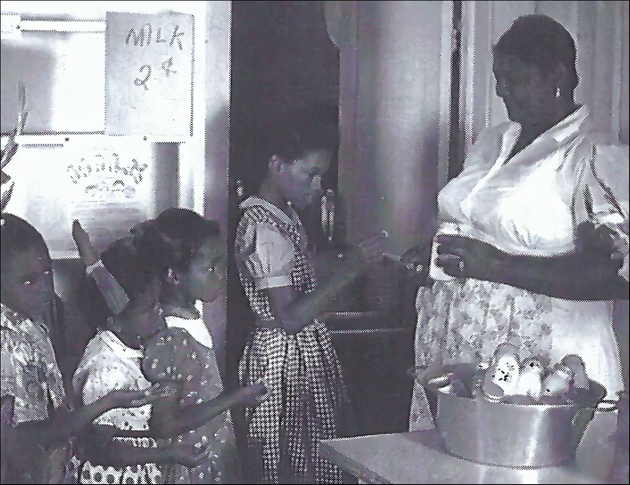Year
2023
Artist
Location
Baker Center School
311 E. Charlotte Avenue
Size
104′ w x 8.5′ h
Mural Creation Sponsors
2023:
Sushila Cherian
In Memory of Dr. JV Cherian
Congregational United Church of Christ
Kelly & Pete Gaylord
The Patterson Foundation
Saint Mary Baptist Church
In Memory of Pastor Isaac Thomas Jr
Community Foundation of Sarasota County
Shively Charitable Foundation
Lt. Col. Scot & Jill Shively
Penny Stiffler
The Community
Panel 4 – Education 2
To listen to an audio presentation of the history captured in this panel, click on this video.
In 1942 a new segregated school was built for Charlotte County “colored” students on Charlotte Avenue. It was named Baker Elementary School in Benjamin Baker’s honor (see Panel 3 for more about Mr. Baker) and continued to include grades 1-8. It was still referred to as “Baker Academy.”
In 1935, Mary Nightingale and her husband Abe moved to the small community of McCall that at the time consisted of about 50 white and African American residents. Abe worked in a citrus grove and as a preacher, and Mary raised cattle. Mary eventually sold her cattle, and in 1942, began driving the county school bus for Baker Academy.
Since the Academy was the only school for African Americans in the area, children were bussed from across the county to Punta Gorda. “Students on Gasparilla Island had to rise at 4 a.m. to catch the bus and ferry,” recalled local John Allen. “They reached home again at 8 p.m.” Mary would first drive to Englewood to pick up children there, then come back and pick up children in McCall, Murdock, and then on to Punta Gorda. “The first bus was rickety,” said Mary in a 1970’s interview. “And I have to jump down every mile at least and put water in the radiator. Took the water outa the ditch.”
She took interest in every child and made sure they got to school. “Sometimes a boy or girl wouldn’t be at the bus stop and I just knew they were trying to play hooky. I would get off the bus, go in their house and pull ’em out of bed and get ’em on the bus. In later years when I would see ’em, we would laugh and laugh about that. But somebody had to get those children to school to get some education,” recalled Mary. She never had any trouble with any of the children in her care and didn’t have a substitute driver to help her for the first 17 years.

When she reached Punta Gorda each day, Mary would start her second job as the cook for the Academy. “I use to go to the high school. Charlotte High School. And get milk and sandwiches and bring ’em to the colored school. Baker Academy. They finally gives me commodities for the kitchen at the school and I’d make drinks for the kids. They call ’em lilly dillies. I’d sell ’em and charge the boys and girls five cents each drink. Then I took this money and bought meat so I can fix lunches for the children. These cost 15 cents each child. … I run the lunch room by myself,” recalled Mary.
Mary drove the school bus for Charlotte County for 19 years and 4 months. She was fired in 1964, just five months before she could retire. “They told me they were going to have another driver, a white man. Integration had come about. You see now there were a lot of white kids getting on the bus, and some of the parents in Englewood didn’t want their kids being driven by a black person,” stated Mary. “But I guess what was important,” she remembered, “was all those 19 years and 4 months, I at least got those kids to school.”
“Sick or well, Mary drove that bus for years. She was determined to do her part in helping those kids get some education — education she had been unable to get. A lot of people around here thought Mary was a real heroine,” said Martha Conway, who knew Mary well and is the great-granddaughter of William Goff, Englewood’s first pioneer.
Panel 4 of the new Local Black History mural captures the 1942 school along with Mary Nightingale and her school bus.






 Support Provided by the Community Foundation of Sarasota County & the Shively Charitable Foundation
Support Provided by the Community Foundation of Sarasota County & the Shively Charitable Foundation